Dominic Flynn
School of Civil Engineering
University of Birmingham
E-mail: flynndc@bham.ac.uk
Supervisors: Dr Hassan Hemida, Professor Chris Baker
Background
When a train moves through the air it generates a slipstream which, to a static observer, appears as a gradually-building gust punctuated by pressure and velocity transients. The concept of a slipstream is well known by the general public and is colloquially referred to as ‘air turbulence’ on station platform signs and by audible announcements.
Freight trains are generally bluffer than passenger trains and often have uneven loading which have been shown to cause greater slipstream velocities. Between 1972 and 2005 there were 26 documented incidents as a result of slipstream gusts on station platforms and at trackside on the UK rail network. These incidents involved the unsteadiness of persons and the movement of objects and pushchairs on station platforms and at trackside. During full-scale experiments freight trains were shown to cause a higher level of pushchair movement than passenger trains even though they generally travel much slower.
Full-scale slipstream data in the presence of ambient winds have alluded to the fact that additional winds can significantly increase the velocities measured in the slipstream of a particular train and this effect has been shown to be much more significant for freight trains than for passenger trains. Data of this sort are scarce and because of the variability of ambient winds the data often contain a large degree of scatter. As such it is difficult to establish the exact effect of a single yaw angle on the slipstream velocities so other methods must be used.
Aim
To investigate the effect of crosswinds on the slipstream of a model-scale freight train in order to predict possible consequences to persons within close proximity.
Objectives
- Conduct and validate numerical simulations by subjecting a model-scale Class 66 locomotive-hauled freight train to no crosswind, 10o and 30o crosswinds in order to determine their effect on the slipstream of the train
- Use slipstream velocities obtained from the numerical simulations as inputs to mass-damper model in order to determine effect of slipstream amplification on a range of persons’ stability
Method
In order to establish the effect of a crosswind on the slipstream of the freight train, the slipstream properties are measured when the train is subjected to no-crosswind, a 10° crosswind and a 30° crosswind. Computational fluid dynamics (CFD) is used to obtain an accurate instantaneous and time-averaged view of the slipstream for all three cases.
Delayed detached-eddy simulation (DDES) is a method of CFD which resolves the majority of the flow directly and allows for high-resolution instantaneous data to be obtained (Figure 1, 2). This is more computationally expensive than conventional steady-state calculations but the computational cost is justified by the quality and quantity of the data which can be extracted from the simulations.
Once data are obtained from all three crosswind cases a simple cross-comparison allows for an insight into the effect of the crosswinds chosen on the slipstreams of this particular freight train (Figure 3).
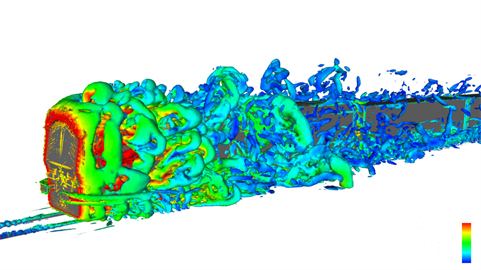
Figure 1: Vortices generated around the Class 66 locomotive represented by an isosurface of the second invariant of the velocity gradient tensor (Q=75,000) and coloured by velocity
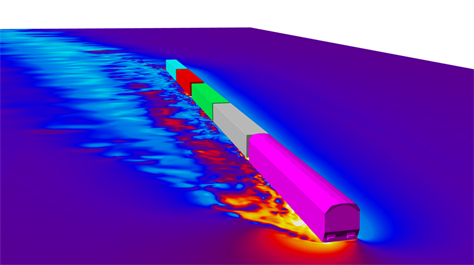
Figure 2: Instantaneous velocity on a plane at mid-height when the freight train is subjected to a 30° crosswind

Figure 3: Time-averaged slipstream velocities measured on the leeward side of the freight train for the no-crosswind, 10° crosswind and 30° crosswind cases
Once the velocities are obtained from the slipstream of the freight train in all yaw angle cases, then the potential effect on people and pushchairs can be investigated. The velocities on the leeward side of the freight train for all three cases were used as inputs for the previously-developed spring-mass-damper model (Figure 4). By using the stability model the effect of the slipstream amplification on persons can be approximated and the data used in risk analyses.
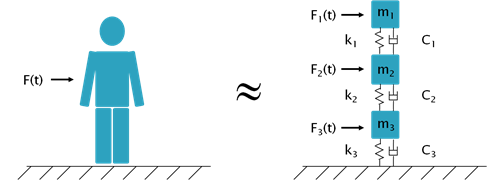
Figure 4: Schematic of the previously-developed spring-mass-damper model employed in this work
Supplementary consulting work: Simulation of track switches using finite element methods
Collaborative research between the Birmingham Centre for Railway Research and Education (BCRRE) and Network Rail was conducted to establish the effect of introducing new parts (Figure 5) to two current track switch mechanisms. The work was carried out using Abaqus Explicit and aimed to determine whether a train going through the switch (Figure 6), if it is locked the wrong way, would de-rail the train or cause permanent damage to the mechanism. The simulations allowed investigators to determine the stress levels on every deformable part within the mechanism.
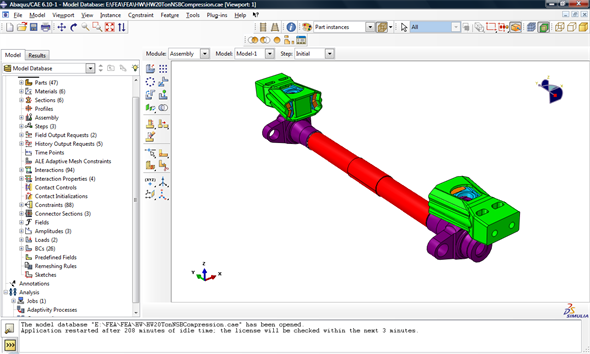
Figure 5: New design of stretcher bar
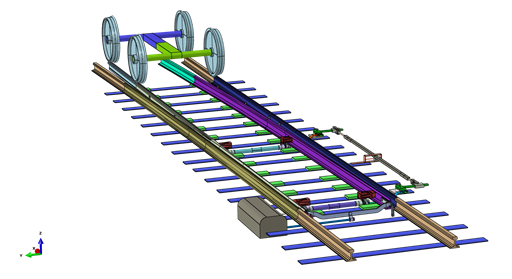
Figure 6: Full-depth switch layout